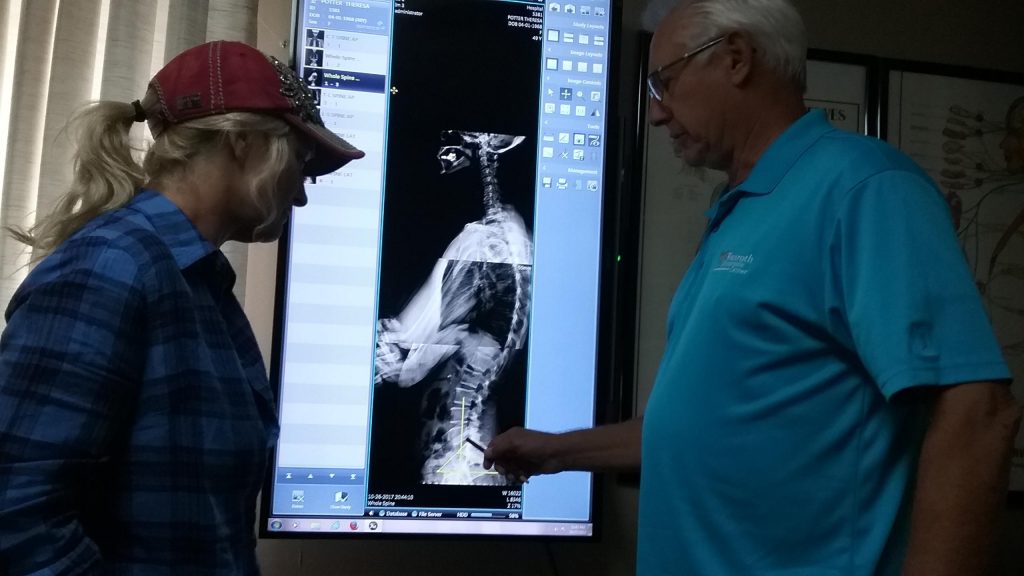Chiropractic can be alternative to surgery, drugs

Tom Rexroth, a fourth-generation chiropractor of Rexroth Chiropractic Center in West Burlington, and his son, Joel, a fifth-generation chiropractor, see people referred to them by medical doctors for treatment every week, but that hasn’t always been the case.
“I’ve been in practice 46 years, so in that period of time, it went from medical doctors telling their patients, ‘If you see a chiropractor, never come back here,’ it’s gone from that to… now the MDs will actually encourage them to go see a chiropractor,” Rexroth said.
He attributed the increase in doctor referrals to a growing number of studies supporting the effectiveness and range of chiropractic treatment, as well as improvements in imaging technology, show chiropractic treatment can, in many cases, alleviate chronic pain, making it a safe — and less costly — alternative to prescription opioids, over-the-counter pain killers and even surgery.
Chiropractic and other holistic practices often have better outcomes than surgery, with patients returning to work sooner, and the Ohio Bureau of Workers’ Compensation recently adopted a spinal fusion rule to discourage unnecessary surgery and opioid use. The rule requires workers to undergo at least 60 days of comprehensive conservative care, including physical therapy, chiropractic care and rest, anti-inflammatories, ice and other non-surgical treatments for 60 days before considering surgical options. Similar guidelines and protocols are in place in Washington and Wyoming.
“It’s pretty simple and not scary,” Rexroth said of chiropractic care as he used a device called an activator to apply a precise amount of pressure to specific location in the joint connecting Theresa Potter’s leg to her pelvis. The activator is used to “tap things into place” when manual adjustments may cause the patient pain or discomfort, most often when working in an area of the body where injury is present.
Days prior, Potter hit her head on a beam while riding bareback on a horse. The blow resulted in head-to-toe pain. She wasn’t there on a doctor referral. In fact, she hadn’t even seen her regular doctor after the accident. Having gone to the chiropractic center several years prior following an automobile accident, she was there because experience taught her Rexroth likely could fix the root of her pain, which lies in pinched nerves and spinal subluxations, which are anything less than dislocations.
Potter also took her daughter to Rexroth for a twisted knee. She said surgery had been recommended, but Rexroth was able to fix it.
“I know to come here first,” said Potter, who had at least four weeks of corrective care ahead of her.
“And that’s actually a good idea in a lot of conditions, to go to a chiropractor first, because chiropractic treatment either helps people or it doesn’t help people. Very seldom does it hurt people,” Rexroth added. “While, with drugs and surgery, you’re having to choose lesser of evils. You take this drug that has this bad side effect, or do you have surgery and all the scar tissue that goes with that?”
Corrective care requires several visits each week for two weeks before tapering it down to two visits a week for the next two weeks. At the end of the four-week period, a series of non-invasive tests and x-rays, the same done during the initial visit, are used to evaluate improvement and decide the course of further care, which can be anywhere from continued weekly visits to monthly visits or none at all, though monthly visits are recommended to maintain musculoskeletal positioning. If the tests show significant improvement has not been made, patients are referred elsewhere for appropriate treatment.
“Drugs and surgeries can force things to happen,” Rexroth said. “The only time we can help people is if we’re getting at the cause of the problem and if the nervous system and joint mobility is part of the problem.”
In addition to headaches and other aches and pains, nervous system and joint mobility issues can be the cause of some surprising symptoms, including asthma, sinus troubles, high blood pressure and gastrointestinal problems.
Rexroth recalled an 8-month-old patient suffering severe constipation. The child had never had a normal bowel movement and plans were underway for exploratory surgery.
“The mother wasn’t excited about that, so a friend said, ‘Well take him to a chiropractor,’ which, you know, most people wouldn’t even think about, but she brought him out and my son, Dr. Joel, checked him over,” Rexroth said.
Joel discovered a subluxated vertebrae in the child’s lower back where nerves connect to the colon.
“That day, he had his first normal bowel movement in his life, and he’s been fine ever since then,” Rexroth said proudly.
Another woman’s children suffered asthma and frequent bronchitis, so much so they missed months of school. It turned out they had vertebrae problems in their necks and shoulders. After correcting those problems, they had nearly perfect attendance.
“Your whole body tends to be healthier and more resistant to disease if you have chiropractic care,” Rexroth said.
He himself gets adjusted about every two weeks. In his 46 years of practice, he’s missed only three days of work due to illness.
